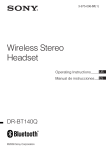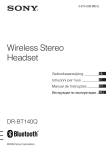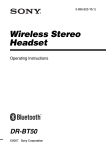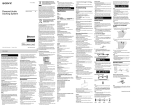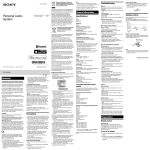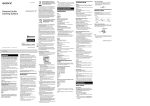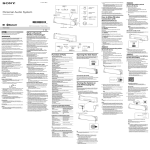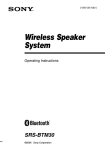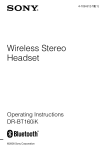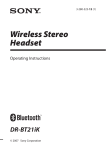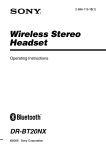Download DR-BT140Q
Transcript
3-875-096-11(1) Wireless Stereo Headset Operating Instructions DR-BT140Q ©2008 Sony Corporation WARNING To reduce the risk of fire or electric shock, do not expose this apparatus to rain or moisture. To reduce the risk of electrical shock, do not open the cabinet. Refer servicing to qualified personnel only. Do not install the appliance in a confined space, such as a bookcase or built-in cabinet. To reduce the risk of fire, do not cover the ventilation of the apparatus with newspapers, tablecloths, curtains, etc. And do not place lighted candles on the apparatus. To reduce the risk of fire or electric shock, do not place objects filled with liquids, such as vases, on the apparatus. Connect the AC power adaptor to an easily accessible AC outlet. Should you notice an abnormality in the AC power adaptor, disconnect it from the AC outlet immediately. Do not expose the batteries (battery pack or batteries installed) to excessive heat such as sunshine, fire or the like for a long time. Excessive sound pressure from headphones can cause hearing loss. The Bluetooth word mark and logos are owned by the Bluetooth SIG, Inc. and any use of such marks by Sony Corporation is under license. Other trademarks and trade names are those of their respective owners. MPEG Layer-3 audio coding technology and patents licensed from Fraunhofer IIS and Thomson. 2 US Notice for customers: the following information is only applicable to equipment sold in countries applying EU directives The manufacturer of this product is Sony Corporation, 1-7-1 Konan, Minato-ku, Tokyo, Japan. The Authorized Representative for EMC and product safety is Sony Deutschland GmbH, Hedelfinger Strasse 61, 70327 Stuttgart, Germany. For any service or guarantee matters please refer to the addresses given in separate service or guarantee documents. Hereby, Sony Corp., declares that this equipment is in compliance with the essential requirements and other relevant provisions of Directive 1999/5/EC. For details, please access the following URL : http://www.compliance.sony.de/ Use of this radio equipment is not allowed in the geographical area within a radius of 20 km from the centre of Ny-Alesund, Svalbard in Norway. Disposal of Old Electrical & Electronic Equipment (Applicable in the European Union and other European countries with separate collection systems) This symbol on the product or on its packaging indicates that this product shall not be treated as household waste. Instead it shall be handed over to the applicable collection point for the recycling of electrical and electronic equipment. By ensuring this product is disposed of correctly, you will help prevent potential negative consequences for the environment and human health, which could otherwise be caused by inappropriate waste handling of this product. The recycling of materials will help to conserve natural resources. For more detailed information about recycling of this product, please contact your local Civic Office, your household waste disposal service or the shop where you purchased the product. Disposal of waste batteries (applicable in the European Union and other European countries with separate collection systems) This symbol on the battery or on the packaging indicates that the battery provided with this product shall not be treated as household waste. By ensuring these batteries are disposed of correctly, you will help prevent potentially negative consequences for the environment and human health which could otherwise be caused by inappropriate waste handling of the battery. The recycling of the materials will help to conserve natural resources. In case of products that for safety, performance or data integrity reasons require a permanent connection with an incorporated battery, this battery should be replaced by qualified service staff only. To ensure that the battery will be treated properly, hand over the product at end-oflife to the applicable collection point for the recycling of electrical and electronic equipment. For all other batteries, please view the section on how to remove the battery from the product safely. Hand the battery over to the applicable collection point for the recycling of waste batteries. For more detailed information about recycling of this product or battery, please contact your local Civic Office, your household waste disposal service or the shop where you purchased the product. US 3 US 4 US Table Of Contents What is Bluetooth wireless technology? .................. 6 Welcome! .......................... 7 3 steps to Bluetooth function .... 8 Location and Function of Parts ............................... 9 Charging the unit ........... 10 Pairing ............................. 12 What is pairing? ...................... 12 Procedures of pairing .............. 12 US Wearing the unit ............. 14 Indications of Bluetooth function ....................... 15 Listening to music ......... 16 Controlling the audio device – AVRCP ............................... 17 Calling ............................. 19 Controlling the Bluetooth mobile phone – HFP, HSP ............................ 21 Calling while playing back music .................. 22 Precautions .................... 23 Troubleshooting ............. 25 Initializing the unit ......... 27 Specifications ................. 28 5 US What is Bluetooth wireless technology? Bluetooth® wireless technology is a short-range wireless technology that enables wireless data communication between digital devices, such as a computer or digital camera. Bluetooth wireless technology operates within a range of about 10 meters (about 30 feet). Connecting two devices as necessary is common, but some devices can be connected to multiple devices at the same time. You do not need to use a cable for connection, nor is it necessary for the devices to face one another, such is the case with infrared technology. For example, you can use such a device in a bag or pocket. Bluetooth standard is an international standard supported by thousands of companies all over the world, and employed by various companies worldwide. Communication System and Compatible Bluetooth Profiles of this unit Profile is standardization of the function for each Bluetooth device specification. This unit supports the following Bluetooth version and profiles: 6 US Communication System : Bluetooth Specification version 2.0 + EDR*1 Compatible Bluetooth Profiles: – A2DP (Advanced Audio Distribution Profile): Transmitting or receiving audio content of high-quality. – AVRCP (Audio Video Remote Control Profile): Controlling A/V equipment; pausing, stopping, starting playback, volume control, etc. – HSP (Headset Profile)*2: Talking on the phone/Operating the phone. – HFP (Hands-free Profile)*2: Talking on the phone/Operating the phone by hands-free. *1 Enhanced Data Rate *2 When you use a Bluetooth mobile phone supported by both HFP (Handsfree Profile) and HSP (Headset Profile), set to HFP. Notes • To be able to use the Bluetooth function, the Bluetooth device to be connected requires the same profile as the unit’s. Note also that even if the same profile exists, devices may vary in function depending on their specifications. • Due to the characteristic of Bluetooth wireless technology, the sound played on this unit is slightly delayed from the sound played on the Bluetooth device during talking on the telephone or listening to the music. Welcome! Thank you for purchasing this Sony Wireless Stereo Headset. This unit uses Bluetooth wireless technology. • Enjoy music wirelessly from Bluetooth Stereo-enabled music players and mobile phones.*1 • Talk hands-free with Bluetooth technology-enabled mobile phones.*2 • Enjoy basic remote control operation (play, stop, etc.) of music player functions via Bluetooth connection.*3 • Bluetooth version 2.0 + EDR*4 for higher quality audio with less interference and lower power consumption. • Useful rechargeable function. For details on Bluetooth wireless technology, see page 6. Talking on the phone Listening to music *1 The connected Bluetooth device is required to support A2DP (Advanced Audio Distribution Profile). *2 The connected Bluetooth device is required to support HFP (Hands-free Profile) or HSP (Headset Profile). *3 The connected Bluetooth device is required to support AVRCP (Audio Video Remote Control Profile). *4 Enhanced Data Rate 7 US 3 steps to Bluetooth function Pairing First, register (“pair”) a Bluetooth device (mobile phone, etc.) and this unit with each other. Once pairing is established, there is no need for pairing again. Bluetooth mobile phone, etc. Wireless Stereo Headset Pairing c Page 12 - 13 V V Listening to music Calling Bluetooth connection Bluetooth connection Operate the Bluetooth device to make the Bluetooth connection. When the unit is turned on, the unit starts making the Bluetooth connection to the recognized mobile phone automatically. Connection A2DP AVRCP Connection c Page 16 V Listening to music You can listen to music played on the Bluetooth device. Playback, stop, or pause is possible from this unit. HFP HSP c Page 19 - 20 V Talking on the phone You can make and receive a call by operating this unit. Music Voice 8 US c Page 16 - 18 c Page 20 - 22 GETTING STARTED Location and Function of Parts 1 Jog switch 7 RESET button Controls various functions when listening to music. Push this button when this unit does not operate properly. Pairing information is not deleted by this operation. 2 Indicator (red) Indicates the power status of the unit. 3 Indicator (blue) Indicates the communication status of the unit. 4 VOL (Volume) – button 5 VOL (Volume) +* button 6 POWER button 8 Microphone 9 Multi function button Controls various call functions. 0 PAIRING button qa Cord slider Use to adjust the cord of the unit. qs DC IN 3 V jack * This button has a tactile dot. 9 US Charging the unit The unit contains a rechargable Lithium-Ion battery, which should be charged before using for the first time. 1 Connect the supplied AC power adaptor to the DC IN 3 V jack on the unit. To an AC outlet AC power adaptor (supplied) To DC IN 3 V jack Tips • If the AC power adaptor is connected to an AC outlet while the unit is turned on, the unit will be turned off automatically. • This unit cannot be turned on while charging. US (red) lights up while charging. Wireless Stereo Headset When the AC power adaptor is connected to an AC outlet, charging starts. 10 2 Make sure that indicator Charging is completed in about 2.5 hours* and the indicator (red) goes off automatically. * Time required for empty battery to recharge. Note If this unit is not used for a long time, the indicator (red) may not light up when you connect the AC power adaptor to charge this unit. In this case, do not disconnect the AC power adaptor from the unit and wait until the indicator (red) lights up. Caution If this unit detects a problem while charging, the indicator (red) may turn off, although charging is not complete. Check for the following causes: – Ambient temperature exceeds the range of 0 °C – 45 °C (32 °F – 113 °F). – There is a problem with the battery. In this case, charge again within the above-mentioned temperature range. If the problem persists, consult your nearest Sony dealer. Notes • If the battery is not used for a long time, battery may be quickly depleted, however, after a few recharges, battery life will improve. • If the life of the built-in rechargeable battery drops to half the normal length, the battery should be replaced. Consult your nearest Sony dealer for replacement of the rechargeable battery. • Avoid exposure to temperature extremes, direct sunlight, moisture, sand, dust or mechanical shock. Never leave in a car parked in the sun. • Use only the supplied AC power adaptor. Do not use any other AC power adaptor. Usage hours* Checking the remaining battery When pressing the POWER button while the unit is turned on, the indicator (red) flashes. You can check the remaining battery by the number of times the indicator (red) flashes. Indicator (red) Status 3 times Full 2 times Mid 1 time Low (needs to charge) Note Status Approx. usage hours Communication time (including music playback time) (up to) 12 hours Standby time (up to) 200 hours You cannot check the remaining battery immediately after the unit is turned on, or while pairing. When the battery is almost empty The indicator (red) flashes slowly automatically. When the battery becomes empty, a beep sounds and the unit will turn off automatically. * Time stated above may vary, depending on ambient temperature or conditions of use. 11 US Pairing What is pairing? Bluetooth devices need to be “paired” with each other beforehand. Once Bluetooth devices are paired, there is no need for pairing again, except in the following cases: • Pairing information is deleted after repair, etc. • This unit is paired with 9 or more devices. This unit can be paired with up to 8 devices; if a new device is paired after 8 devices have been paired, the device whose latest connection time is the oldest among the 8 paired devices is replaced by the new one. • When recognition of the unit by the device to be connected is deleted. • This unit is initialized (page 27). All pairing information is deleted. Procedures of pairing 1 Place the Bluetooth device within 1 m (3 ft) of this unit. 2 Press and hold the PAIRING button for 2 seconds or more to standby for pairing. The indicator (blue) and indicator (red) flash together and the unit enters into pairing mode. Note If pairing is not established within about 5 minutes, pairing mode will be cancelled and this unit will turn off. In this case, start over from step 1. 12 US 3 Perform pairing procedure on the Bluetooth device to detect this unit. The list of detected devices appears on the display of the Bluetooth device. This unit is displayed as “DR-BT140Q.” If “DR-BT140Q” is not displayed, repeat from step 1. Notes • For details, refer to the operating instructions supplied with the Bluetooth device. • When pairing with a Bluetooth device that cannot display a list of detected devices or that has no display, you may pair the device by setting both this unit and the Bluetooth device to pairing mode. At this time, if passcode is set besides “0000” on the Bluetooth device, pairing cannot be done with this unit. 6 Start the Bluetooth connection from the Bluetooth device. This unit memorizes the device as the last connected device. Some Bluetooth devices may connect with the unit automatically when pairing is complete. Tips • To pair with other Bluetooth devices, repeat steps 1 to 5 for each device. • To delete all pairing information, see “Initializing the unit” (page 27). 4 Select “DR-BT140Q” on the display of the Bluetooth device. 5 If Passcode* input is required on the display of a Bluetooth device, input “0000.” Pairing is complete when the indicator (blue) flashes slowly. The message standing for “Pairing complete” appears on the display of some Bluetooth devices. * Passcode may be called “Passkey,” “PIN code,” “PIN number,” or “Password.” 13 US Wearing the unit 1 Place the tip of the 2 Adjust the cord of the unit. hanger at the upper base of the ear and push it down along the back of the ear. You can adjust the cord by using the cord slider. Wear the housing marked R in your right ear and the one marked L in your left ear. Tip After using this unit, you can bundle up it with the cord slider. 14 US Indications of Bluetooth function B : Indicator (blue) R : Indicator (red) B R Connectable – – B R – – – – – – – – – ... Connecting B R – – – – – – – – – – – – – – – – – – – – ... ... Phone Music Connected Pairing Flashing patterns Searching Connecting Status HFP/HSP or A2DP B (standby for receiving audio signal) – – – – – – – – – – – – – – – ... – ... – – – – – – – – – – – – – – ... – – R – HFP/HSP and A2DP B – – – – – – – – – – ... (standby for receiving audio signal) R – Listening B R – – – – – – – – – – – – – ... Listening during standby B for telephone call R – – – – – – – – – – – ... ... Incoming call B R – Talking B R – – – – – – – – – – – – – ... Calling while B playing back music R – – – – – – – – – – – ... 15 US OPERATING THE UNIT Listening to music When not calling with this unit, do not make the last connected Bluetooth device ready for HFP or HSP connection. To make or receive a call while playing back music, see page 22. VOL – button VOL + button POWER button 2 Make the Bluetooth connection (A2DP) from a Bluetooth device to this unit. > Refer to the operating instructions supplied with the Bluetooth device on how to operate it. Nx . Check the following before operating the unit. – The Bluetooth device is turned on. – Pairing of this unit and the Bluetooth device is complete. – The Bluetooth device supports the transmitting music function (profile: A2DP*). 3 Start playback on the 1 Press and hold the Notes POWER button for about 2 seconds while the unit is turned off. The indicator (blue) and indicator (red) flash together twice and the unit is turned on. Note After the unit is turned on, the unit attempts to connect to the last connected Bluetooth device automatically with HFP or HSP. 16 US Bluetooth device. Tip Bluetooth connection of A2DP (Advanced Audio Distribution Profile) can also be operated with the jog switch from this unit to the Bluetooth device except when making a call on this unit. • When you play music by connecting the unit to a Bluetooth device using HSP (Headset Profile), sound quality will not be high. For better sound, change the Bluetooth connection to A2DP by operating the Bluetooth device. • If this unit is turned off while an A2DP Bluetooth connection is established, operate the unit again from step 1 to make the A2DP Bluetooth connection again. * For detail on profiles, see page 6. To adjust the volume Press the VOL +/– button while listening to the music. Tips • Depending on the Bluetooth device, it may be necessary to adjust the volume on the connected Bluetooth device as well. • Volume for calling and listening to music can be adjusted independently. Even if you change the volume while calling, the volume for music playback does not change. • The volume level on this unit may vary depending on the connected Bluetooth device. To stop use 1 Terminate the Bluetooth connection by operating the Bluetooth device. 2 Press and hold the POWER button for about 2 seconds. The indicator (blue) and indicator (red) light up together, and the unit turns off. Controlling the audio device – AVRCP If the Bluetooth audio device connected with this unit supports AVRCP (Audio Video Remote Control Profile), you can control by using the unit buttons. Refer to the operating instructions supplied with the Bluetooth device on how to operate it. Note Operation of the Bluetooth connecting device by this unit will vary depending on its specification. Status: In stop or pause mode Short Press Long Press Nx 1 2 ./> 3 4 1 2 3 4 Starts playback*1 Stop Skip to previous/next Fast-rewind/Fast-forward*2 Status: In play mode Short Press Long Press Tip Nx 5 6 When you finish playing music, the Bluetooth connection may terminate automatically, depending on the Bluetooth device. ./> 7 8 5 6 7 8 Pause*1 Stop Skip to previous/next Fast-rewind/Fast-forward*2 *1 You may need to press the button twice depending on the Bluetooth device. *2 Some Bluetooth devices may not operate. Continued 17 US Tip Depending on the Bluetooth device, the fast-forward or fast-rewind operation can be done by performing the following procedures on this unit. 1 Press and hold the POWER button for about 2 seconds to turn off the unit. 2 Press and hold the POWER button and jog switch (Nx) for about 7 seconds. The indicator (blue) flashes once. The setting can be released by repeating the above procedures. At this time, the indicator (blue) flashes twice. Note You cannot adjust the volume of the Bluetooth device by pressing the VOL +/– button of this unit. 18 US Calling VOL – button VOL + button When this unit does not connect to a Bluetooth mobile phone automatically POWER button You can make a connection by operating Bluetooth mobile phone or by operating this unit to connect the last connected Bluetooth device. Multi function button Check the following before operating the unit. – The Bluetooth function is active on the mobile phone. – Pairing of this unit and the Bluetooth mobile phone is complete. 1 Press and hold the POWER button for about 2 seconds while the unit is turned off. The indicator (blue) and indicator (red) flash together twice, the unit turns on and then this unit tries to connect to the last Bluetooth mobile phone that was used. Tip This unit will stop trying to connect to the Bluetooth mobile phone after 1 minute. In such a case, press the multi function button to try to connect again. A To make a connection by operating Bluetooth mobile phone 1 Make the Bluetooth connection (HFP or HSP*) from the Bluetooth mobile phone to this unit. Refer to the manual supplied with your Bluetooth mobile phone for operation details. The list of recognized devices appears on the display of the Bluetooth mobile phone. This unit is displayed as “DR-BT140Q.” When you use the Bluetooth mobile phone features both HFP (Hands-free Profile) and HSP (Headset Profile), set to HFP. Note When connecting to a Bluetooth mobile phone which is different from the last connected one, make the connection following the above procedure. * For details on profiles, see page 6. Continued 19 US B To make a connection with the last connected Bluetooth device by operating this unit 1 Press the multi function button. When listening to music with this unit, a Bluetooth connection cannot be made with the multi function button. To call To adjust the volume 1 Use the buttons on your Press the VOL +/– button. Note mobile phone when making a call. If no dial tone is heard on this unit, press and hold the multi function button for about 2 seconds. Tip Tips • You cannot adjust the volume when not communicating. • Volume for calling and listening to music can be adjusted independently. Even if you change the volume while playing back the music, the volume of a call does not change. You can call in the following way, depending on the Bluetooth mobile phone. Refer to the manual supplied with your mobile phone on operating details. – When not communicating, you can call using the voice-dial function by pressing the multi function button. – You can call the last dialed number by pressing the multi function button for about 2 seconds. To terminate a call To receive a call 2 Press and hold the When an incoming call arrives, a ring tone will be heard from the unit. 1 Press the multi function button on the unit. US Note If you received a call by pressing the button on the Bluetooth mobile phone, some Bluetooth mobile phones may have handset use priority. In this case, set to talk with the unit by pressing and holding the multi function button for about 2 seconds, or by operating the Bluetooth mobile phone. For details, refer to the manual supplied with your Bluetooth mobile phone. The indicator (blue) and indicator (red) start flashing at the same time, and the unit performs the connection operation for about 5 seconds. 20 – ring tone set on the unit – ring tone set on the mobile phone – ring tone set on the mobile phone only for Bluetooth connection The ring tone differs in the following ways, depending on your mobile phone. You can end a call by pressing the multi function button on the unit. To stop use 1 Terminate Bluetooth connection by the Bluetooth mobile phone. POWER button for about 2 seconds to turn off the power. The indicator (blue) and indicator (red) light up together, and the unit turns off. Controlling the Bluetooth mobile phone – HFP, HSP The operation of the buttons on this unit varies depending on your mobile phone. HFP (Hands-free Profile) or HSP (Headset Profile) is used for Bluetooth mobile phone. Refer to the operating instructions supplied with your Bluetooth mobile phone on supported Bluetooth profiles or how to operate. *1 Some functions may not be supported depending on the Bluetooth mobile phone. Refer to the operating instructions supplied with your mobile phone. 2 * This may vary, depending on the Bluetooth mobile phone. *3 Some functions may not be supported when calling using the Bluetooth mobile phone. HFP (Hands-free Profile) Status Standby Voice Dial active Multi function button Short Press Long Press Start Voice Dial*1 Last number redial Cancel Voice Dial*1 – Outgoing call End outgoing call Change call device Incoming call Answer Reject During call End call Change call device HSP (Headset Profile) Status Standby Multi function button Short Press Long Press – Dial*1 Outgoing call End outgoing End outgoing call*1 call or change call device to headset*2 Incoming call During call Answer – End call*3 Change call device to headset 21 US Calling while playing back music The Bluetooth connection using HFP or HSP as well as A2DP is necessary to make a call while playing back music. For example, to make a call using a Bluetooth mobile phone while listening to music on a Bluetooth compatible music player, this unit needs to be connected to the mobile phone using HFP or HSP. Make a Bluetooth connection between this unit and the device in use following the procedures outlined below. 1 Make a Bluetooth connection between this unit and the mobile phone in use with HFP or HSP following the procedures outlined in “Calling” (see page 19). 2 Operate the Bluetooth device (music player or mobile phone) used for playing the music to make a Bluetooth connection to this unit using A2DP. To make a call while playing back music To receive a call while playing back music 1 Press the multi function When an incoming call arrives, the music pauses and the ring tone is heard from this unit. button while playing back music (page 21), or operate your Bluetooth mobile phone to make a telephone call. If no dial tone is heard on this unit, press and hold the multi function button for about 2 seconds. 1 Press the multi function button and talk. After finishing the call, press the multi function button. This unit is switched back to music playback. When no ring tone is heard even if an incoming call arrives 1 Stop music playback. 2 When ringing, press the multi function button and talk. 22 US ADDITIONAL INFORMATION Precautions On Bluetooth communication • Bluetooth wireless technology operates within a range of about 10 meters (about 30 feet). Maximum communication range may vary depending on obstacles (human body, metal, wall, etc.) or electromagnetic environment. • The antenna is built into the right housing as illustrated in the dotted line. The sensitivity of the Bluetooth communication will improve by placing a connected Bluetooth device on your right side. The communication distance shortens when the obstacles are between the antenna of the connected device and this unit. • • • Location of built-in antenna • The following conditions may affect the sensitivity of Bluetooth communication. – There is an obstacle such as a human body, metal, or wall between this unit and Bluetooth device. – A device using 2.4 GHz frequency, such as a wireless LAN device, cordless telephone, or microwave oven, is in use near this unit. • Because Bluetooth devices and wireless LAN (IEEE802.11b/g) use the same frequency, microwave interference may occur and resulting in communication speed deterioration, noise, or invalid connection if this unit is used near a wireless LAN device. In such as case, perform the following. – Use this unit at least 10 m (about 30 ft) away from the wireless LAN device. • • – If this unit is used within 10 m (about 30 ft) of a wireless LAN device, turn off the wireless LAN device. – Install this unit and Bluetooth device as near to each other as possible. Microwaves emitting from a Bluetooth device may affect the operation of electronic medical devices. Turn off this unit and other Bluetooth devices in the following locations, as it may cause an accident. – where inflammable gas is present, in a hospital, train, airplane, or a petrol station – near automatic doors or a fire alarm This unit supports security capabilities that comply with the Bluetooth standard to provide a secure connection when the Bluetooth wireless technology is used, but security may not be enough depending on the setting. Be careful when communicating using Bluetooth wireless technology. We do not take any responsibility for the leakage of information during Bluetooth communication. Connection with all Bluetooth devices cannot be guaranteed. – A device featuring Bluetooth function is required to conform to the Bluetooth standard specified by Bluetooth SIG, Inc. and be authenticated. – Even if the connected device conforms to the above mentioned Bluetooth standard, some devices may not be connected or work correctly, depending on the features or specifications of the device. – While talking on the phone hands free, noise may occur, depending on the device or communication environment. Depending on the device to be connected, it may require some time to start communication. Continued 23 US On the supplied AC power adaptor • Use the AC power adaptor supplied with this unit. Do not use any other AC power adaptor since it may cause the unit to malfunction. Polarity of the plug • If you are not going to use this unit for a long time, unplug the AC power adaptor from the AC outlet. To remove the AC power adaptor from the wall outlet, grasp the adaptor plug itself; never pull the cord. 24 US Others • Do not place this unit in a place exposed to humidity, dust, soot or steam, subject to direct sunlight, or in a car waiting at a traffic signal. It may cause a malfunction. • Using the Bluetooth device may not function on mobile phones, depending on radio wave conditions and location where the equipment is being used. • If you experience discomfort after using the Bluetooth device, stop using the Bluetooth device immediately. Should any problem persist, consult your nearest Sony dealer. • Listening with this unit at high volume may affect your hearing. For traffic safety, do not use this unit while driving or cycling. • Do not put weight or pressure on this unit as it may cause the unit to deform during long storage. • The ear pads may deteriorate due to long-term storage or use. • If you have any questions or problems concerning this unit that are not covered in this manual, please consult your nearest Sony dealer. Troubleshooting If you run into any problems using this unit, use the following checklist and read the product support information on our website. Should any problem persist, consult your nearest Sony dealer. Common The unit is not turned on. The correspondence distance is short. (Sound skips.) , Bring this unit and the Bluetooth device closer together. , If a device that generates electromagnetic radiation, such as a wireless LAN, other Bluetooth device(s), or a microwave oven is nearby, move away from such sources. , Point the antenna of this unit (page 23) towards the Bluetooth device. Make sure no obstacles block the communication. Cannot make the Bluetooth connection. The unit does not operate properly. , Charge the battery of the unit. , The unit is not turned on while charging. Unplug the unit from AC power adaptor and then turn on the unit. Pairing cannot be done. , Check that this unit is turned on. , Check that the Bluetooth connecting device is turned on and the Bluetooth function is on. , Connection with the Bluetooth device may not be memorized on this unit. Make the Bluetooth connection from the Bluetooth device to this unit soon after pairing is complete. , This unit or Bluetooth connecting device is in sleep mode. , The Bluetooth connection is terminated. Make the Bluetooth connection again (when listening to music: see page 16, when calling: see page 19). , Reset the unit. Pairing information is not deleted by this operation. Insert a small pin, etc., into the hole of the RESET button, and push until you feel a click. Distorted sound , Ensure that this unit is not receiving interference from a wireless LAN, other 2.4 GHz wireless device, or microwave oven. 25 US When listening to music No sound , Check that both this unit and the Bluetooth device are turned on. , A2DP Bluetooth connection is not made between this unit and the Bluetooth device. Make an A2DP Bluetooth connection (page 16). , Check that music is being played back by the Bluetooth device. , Check that the volume of the unit is not set too low. , Turn up the volume on the connected device if necessary. , Pair this unit and Bluetooth device again (page 12). Low sound level , Turn up the volume of this unit. , Turn up the volume on the connected device if necessary. Low sound quality , Switch the Bluetooth connection to A2DP (Advanced Audio Distribution Profile) when HSP (Headset Profile) is set. Distorted sound , Turn down the volume of this unit if necessary. Sound skips frequently during playback. , Reception condition of this unit may have become unstable due to improper matching of the bit-rate setting for the music transmitted from the Bluetooth device and the environment in which this unit is used. *1 Terminate A2DP Bluetooth connection by operating the Bluetooth device. While this unit is turned on, press and hold Nx for about 7 seconds to lower the setting of receivable bit rate. *2 26 US *1 Bit rate is a numerical value which represents data transmission volume per second. The higher the bit rate, in general, the better quality the sound will be. This unit can receive high bit rate music but sound skipping may occur depending on the usage environment. *2 When bit rate setting is completed, the indicator (blue) flashes once. The above operations may not reduce the sound skip depending on the usage environment. To reset to the original setting, press and hold Nx again for about 7 seconds. The indicator (blue) flashes twice. When calling The recipient’s voice cannot be heard. , Check that both this unit and the Bluetooth mobile phone are turned on. , Check the connection between this unit and the Bluetooth mobile phone. Make a Bluetooth connection (HFP or HSP) again (page 19). , Check that output of the Bluetooth mobile phone is set for this unit. , Check that the volume of the unit is not set too low. , Turn up the volume on the connected Bluetooth mobile phone if necessary. , If you are listening to music using this unit, stop playback, press the multi function button and talk. Low sound from recipient , Turn up the volume of this unit. , Turn up the volume on the connected Bluetooth mobile phone if necessary. Initializing the unit You can reset this unit to its default (such as volume setting) and delete all pairing information. 1 If this unit is turned on, press and hold the POWER button for about 2 seconds to turn off this unit. 2 Press and hold the POWER button and multi function button together for about 7 seconds. The indicator (blue) and indicator (red) flash together four times, and this unit is reset to the default setting. All pairing information is deleted. 27 US Specifications General Communication System Bluetooth Specification version 2.0 + EDR*1 Output Bluetooth Specification Power Class 2 Power source DC 3.7 V: Built-in lithium-ion rechargeable battery Frequency band 2.4 GHz band (2.4000 GHz – 2.4835 GHz) Mass Approx. 53 g (1.9 oz) Modulation method FHSS Rated power consumption 1.5 W Compatible Bluetooth Profiles*3 A2DP (Advanced Audio Distribution Profile) AVRCP (Audio Video Remote Control Profile) HSP (Headset Profile) HFP (Hands-free Profile) Receiver Supported content protection method SCMS-T Transmission range (A2DP) 20 – 20,000 Hz (Sampling frequency 44.1 kHz) Supplied accessory AC power adaptor (1) Operating instructions (this book) (1) US Headset Maximum communication range Line of sight approx. 10 m (30 ft) *2 Supported Codecs*4 SBC*5, MP3 28 *4 Codec: Audio signal compression and conversion format *5 Subband Codec *1 Enhanced Data Rate *2 The actual range will vary depending on factors such as obstacles between devices, magnetic fields around a microwave oven, static electricity, reception sensitivity, aerial’s performance, operating system, software application, etc. *3 Bluetooth standard profiles indicate the purpose of Bluetooth communication between devices. Type Open air, dynamic Drive unit 30 mm dome type Reproduction frequency range 16 – 24,000 Hz Microphone Type Electret condenser Direction characteristic Omni directional Effective frequency range 100 – 4,000 Hz Operating temperature 0 °C to 45 °C (32 °F to 113 °F) Design and specifications are subject to change without notice. Printed in Malaysia (1)
































